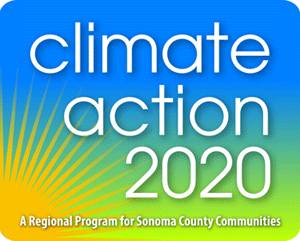“The solution that has resulted in the most significant emission reductions in communities across the U.S. is switching the fuel source from fossil to renewable for electricity. “

Sonoma County needs powerful solutions to meet its bold, science-based 25% GHG emission reduction target. This target was set by resolution in 2005 by all nine Sonoma County cities and the county, demonstrating leadership that goes beyond mere compliance with AB32, California’s Global Warming Solutions Act.
The criteria for solutions used by the Climate Protection Campaign for the Community Climate Action Plan issued in 2008 still apply: 1) significantly reduce emissions, 2) cost effective, 3) under local control, and 4) politically feasible.
So what powerful, community-based solutions exist? To identify them, The Climate Center under contract with the Sonoma County Regional Climate Protection Authority conducted a nationwide scan for proven and promising solutions. This work is part of Climate Acton 2020, a multi-year, million-dollar collaboration of Sonoma County local governments led by the Regional Climate Protection Authority.
We conducted the research for the nationwide scan starting with identifying about 35 high-performing communities around the country. We asked them to take an online survey and a follow up phone interview. Then we compiled the results.
We hoped to discover new silver bullets for reducing emissions. Instead, our findings reinforced what Sonoma County is already doing.
Our key finding is that the solution that has resulted in the most significant emission reductions in communities across the U.S. is switching the fuel source from fossil to renewable for electricity. This finding underscores the conclusion the Climate Protection Campaign reached in 2008 through the Community Climate Action Plan, and justifies the years of education and advocacy for Sonoma Clean Power.
Other successful but less powerful solutions for reducing emissions are found in the solid waste and energy efficiency sectors. Community-scale solutions for reducing emissions from the transportation sector remain elusive for U.S. communities.
We made 18 recommendations in the report broken down by seven categories – from renewable energy to financing to tracking progress and building awareness and support. The report itself is 20 pages, and the appendices which detail our findings total 113 pages. The report is available online: http://staging-theclimatecenter.org/proven-promising-climate-measures-u-s-communities-possible-application-sonoma-county/
We welcome your comments, suggestions, and feedback.
Ann Hancock and Stacey Meinzen

